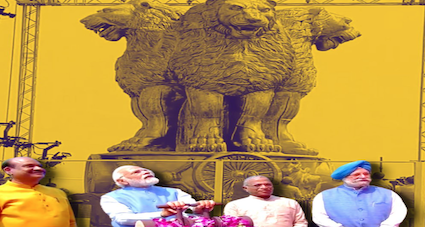In a massive setback for the opposition parties, the Supreme Court on Friday dismissed the petition over the new National Emblem installed atop the new Parliament building. The Apex Court stated that the lion sculpture of the emblem installed atop the new Parliament building does not violate the provisions of the State Emblem of India (Prohibition of Improper Use) Act, 2005.
It further added that the emblem has a visible difference in the design of lions which depicts a changed composure of the lions than that of the symbol preserved in the Sarnath museum. Notably, an arrow erupted after opposition parties raised objections to the new design, citing violation of the constitutional norms noting that the previous Ashoka emblem signified peace, however, the new lions with bared fangs depict ‘aggressiveness’.
It is pertinent to mention that two lawyers Advocates Aldanish Rein and Ramesh Kumar Mishra moved a plea in the Supreme Court claiming that the lions represented in the new emblem unveiled by Prime Minister appear to be “ferocious and aggressive” with their “mouth open and canine visible unlike the State Emblem kept in the Sarnath Museum, where the lions appear to be “calm and composed”.
A bench comprising Justices MR Shah and Krishna Murari rejected the PIL filed by two lawyers. “Having heard the petitioner party-in-person and having gone through the emblem of which the grievance is made, it cannot be said that the same is in any way contrary to the provisions of the Act. It cannot be said that any of the provisions of Act 2005 are violated. The state emblem of India installed on the central vista project, New Delhi cannot be said to be in violation of the Act 2005 at the least. The writ petition is dismissed”, the bench observed in the order.
National Emblem controversy
On July 11, Prime Minister Narendra Modi unveiled the national emblem cast on the roof of the new Parliament building. According to senior officials, the national emblem is built of bronze and has a total weight of 9,500 kg. The national emblem’s height is 6.5 metres and it has been cast at the top of the Central Foyer of the new Parliament building.
The whole episode about the expression of the emblem began after Congress’ Adhir Ranjan Chowdhury requested Prime Minister Modi to observe the face of the Lion. “Whether it is representing the statue of Great Sarnath or a distorted version of GIR lion. Please check it and if it needs, mend the same,” the MP wrote, throwing in a fairly unnecessary jibe at the Gir lion, which should by all estimates be a national treasure.
Thereafter, MP and Trinamool Congress leader Mahua Moitra shared a picture on Twitter highlighting the distinctions and took a dig at the dispensation. Moitra said that the ‘transition from Satyameva Jayate to Singhameva Jayate has long been completed in spirit’. The TMC MP, however, later said she didn’t want to drag lions into the row and changed ‘Singhameva’ to ‘Sanghimeva’.
The State Emblem of India is an adaptation from the Sarnath Lion Capital of Asoka which is preserved in the Sarnath Museum. The Lion Capital has four lions mounted back-to-back on a circular abacus. The frieze of the abacus is adorned with sculptures in high relief of an elephant, a galloping horse, a bull, and a lion separated by intervening Dharma Chakras. The profile of the Lion Capital has been adopted as the State Emblem of India. This finds pride of place and the design is adopted for the emblem above the parliament building.


